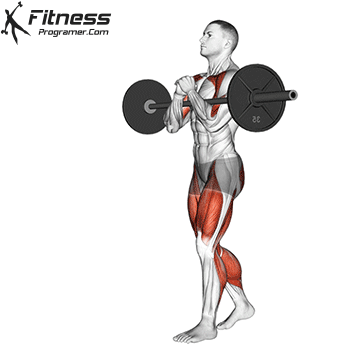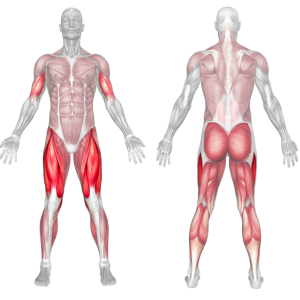Overview
The Zercher carry involves walking while holding a barbell or heavy object in front of the torso, supported in the crease of the elbows. Unlike traditional carries that engage the grip directly, the Zercher position shifts the load forward, forcing the core and upper back to work harder to maintain upright posture and balance. It’s a demanding but highly effective total-body movement. It’s often used in strongman, powerlifting, and functional fitness to build real-world strength and resilience.
How to perform the Zercher Carry

Set a barbell in a squat rack at waist height.
Step up to the bar, bend your arms, and place the bar in the crook of your elbows. Keep your fists close together and elbows under the bar.
Lift the bar by standing tall, bracing your core and keeping your chest high.
Walk forward with small, controlled steps, staying upright and avoiding leaning back or rounding your spine.
Continue walking for a set distance or time, then lower the bar carefully back into the rack or onto pads.
Tips for Proper Form
Keep your elbows tucked and close to the body throughout the walk.
Brace your core tightly before each step.
Maintain an upright posture, avoiding leaning back to offset the load.
Use a towel or pad if needed to reduce pressure on the elbows.
Start light to focus on form before progressing in load.
Common Mistakes
Letting the bar sag by relaxing the core or upper back.
Leaning back excessively, placing strain on the lumbar spine.
Holding the bar too low, which can disrupt balance and stress the shoulders.
Over-striding, making the walk unstable and inefficient.
Neglecting breathing, which reduces core tension and control.
Benefits of Zercher Carry
Enhances Core Stability: The anterior load forces deep core engagement to maintain posture and balance.
Builds Postural Strength: Trains the upper back, traps, and spinal erectors to resist collapsing forward.
Strengthens the Legs and Glutes: Lower body supports the load during walking, reinforcing carryover to squats and deadlifts.
Improves Loaded Carry Mechanics: Develops carry strength without taxing the grip as heavily as farmer’s carries.
Reinforces Bracing Techniques: Teaches proper abdominal bracing under load, helpful for all compound lifts.
Challenges Mental Toughness: The uncomfortable carry position builds grit and focus under fatigue.
Functional and Sport-Specific: Great for athletes in strongman, MMA, rugby, and manual labor professions.
How to Incorporate Into Your Routine
- For Beginners: Start with 2–3 sets of 15–20 meters using a light bar or sandbag.
- For Strength: Perform 3–4 sets of 20–30 meters with a challenging load, focusing on posture.
- For Functional Training: Add to strongman-style circuits with sled pushes, deadlifts, or yoke carries.
- For Circuit Training: Include 20-meter Zercher carries between strength rounds as a conditioning move.
- For General Fitness: Use as a full-body finisher to build posture, endurance, and core control.
- For Injury Resilience: Include light-to-moderate loads in core or rehab days to reinforce bracing.
Zercher Carry Muscles Worked

Frequently Asked Questions
Is the Zercher carry bad for your elbows?
It can feel uncomfortable at first, but using a bar pad or towel helps. Discomfort usually improves with practice.
Can I use something other than a barbell?
Yes. Sandbags, kegs, and stones work well and often feel more natural for some users.
How heavy should I go?
Start with light-to-moderate loads. Progress only after mastering posture and balance.
What’s the difference between the Zercher carry and front carry?
The Zercher carry holds the load in the elbow crease, while a front carry usually involves holding an object at chest level with the arms.
Is this movement beginner-friendly?
Yes, when taught with proper progressions and lighter loads.
